英语说课的六个基本环节
小学英语说课的基本步骤

小学英语说课的基本步骤一、引言英语作为一门外语课程,对于小学生的语言能力的培养具有重要的意义。
而在教师教学过程中,一节成功的英语课程需要经过一系列的准备与布置。
本文将从引言、课程目标、教学重点与难点、教学设计、教学过程、教学手段、教学评价等方面介绍小学英语说课的基本步骤。
二、课程目标在开始准备教学过程之前,教师首先需要明确课程目标。
课程目标的设定应既贴近国家教育标准的要求,又要符合学生的学习情况和能力水平。
比如,在一堂“动物园”主题的英语课堂中,课程目标可以设置为:“通过本节课的学习,学生能够掌握动物名称、形容词的用法,提高他们的听说能力和自信心。
”三、教学重点与难点确定了课程目标之后,教师需要明确教学重点与难点。
教学重点是希望学生能够真正掌握并应用的知识与技能,而教学难点则是学生在学习过程中可能会遇到困难的地方。
在“动物园”主题的英语课堂中,教学重点可以是动物名称的学习与运用,而教学难点可能是形容词的正确运用和对话技巧的提升。
四、教学设计在制定教学设计时,教师应根据学生的年龄、学习特点和教材的内容,结合课程目标与教学重难点,设计有针对性的教学活动。
设计的教学活动既要符合学生的认知规律和兴趣爱好,又能够激发学生的学习热情和积极性。
例如,教师可以设计一个小组活动,让学生在小组内通过角色扮演的方式进行动物对话并呈现给全班。
五、教学过程教学过程分为导入、展示、练习、巩固和拓展等环节。
导入环节是引起学生兴趣和注意力的重要依托,教师可以通过展示图片、播放音频或者提问等方式进行。
展示环节是教师向学生呈现知识的环节,可以通过教师示范、多媒体展示等方式进行。
练习环节是学生进行知识巩固和运用的环节,可以设计各种情境和任务让学生进行口头或书面练习。
巩固环节是对所学知识进行复习和总结的环节,可以通过小结或者测验等方式进行。
拓展环节是对学生进一步学习扩展的环节,可以提供一些延伸阅读或者相关学习资源供学生自主学习。
六、教学手段在教学过程中,教师可根据课程内容与教学目标的需要选择合适的教学手段。
英语“说课”内容及要求

英语学科“说课”的内容及要求“说课”是20世纪80年代后期随着教改深入而产生的,带有教育科研性质的教研活动。
是依据课标、教育教学理念口头表述自己对教学内容、教学目标、重难点、教学方法、教学程序等进行创造性设计的一种教研形式。
(崔小春,2005)“说课”是一种创新的教研教学活动形式,从目前来看,它所产生的教学效果是令人嘱目的。
实践证明,这项活动的产生和发展,极大地推动了课堂教学的改革,丰富了教研活动的内容,促进了课堂教学质量的提高。
通俗地说,就是阐述“教什么内容,为什么教这些内容,怎么教和为什么这样教。
”一、什么叫“说课”所谓“说课”,就是由说课教师面对其他教学或教研人员,根据已确定的课题,运用讲述的方法,分析该课的具体教学设想、教材和学情及其理论依据。
首先,“说课”是一种以教师为对象,在备课与上课之间进行的教学研究活动。
或是一种对其进行教学培训的教学研究活动。
或是一种对其进行教学培训的形式。
其目的就是引导教师,特别是青年教师,研究授课规律,掌握备课方法,克服或避免备课不用功、不认真的毛病;促使教师钻研教材,多查资料,寻找教学重、难点及其教学的理论依据;促使教师既备教材又备学生,不但明白教什么,还应明确怎样教;明确为什么这样教的理论依据,从而减少或避免课堂教学中的盲目性和随意性,提高课堂教学效果。
其次,“说课”这一教学研究形式,能将教师对教材、课标、教法和学法的理解活动由个体转化为群体,通过群体的研究、理解和交流,提高个体在教学中的科学选择能力,从而使教师个体和群体的教学理论水平、教学能力都能迅速地得以提高,进而全面提高教师的素质。
二、“说课”的要求“说课”的程序不是详细的教学过程,也不是具体操作过程,而是主要教学过程的设计和理论依据,是教案的科学化和理性化的升华,也是优质课堂教学过程的一种有效手段和保证,因此,“说课”设计必须建立在严密的理论基础上,“说课”一般都先写出说课稿。
说课讲究的是教材把握精准,教法选择恰当,学法指导有效,板书提纲挈领,过程清晰明朗。
初中英语说课稿流程模板

初中英语说课稿流程模板初中英语说课稿是教师在教学前向学生或同行介绍即将进行的课程内容、教学目标、教学方法和教学过程的一种教学准备材料。
以下是一个初中英语说课稿的流程模板:一、课程基本信息- 课程名称:[课程名称]- 授课教师:[教师姓名]- 授课班级:[班级名称]- 授课时间:[具体时间]- 课程类型:[新课/复习课/练习课等]二、教学目标- 知识与技能目标:学生能够掌握[具体知识点],能够运用[技能]。
- 过程与方法目标:通过[教学方法],培养学生的[思维/解决问题]能力。
- 情感、态度与价值观目标:激发学生对[主题/话题]的兴趣,培养[某种态度或价值观]。
三、教学重点- 明确指出本节课的重点内容,如[语法点/词汇/句型]等。
四、教学难点- 识别并解释学生可能在学习过程中遇到的难点,以及如何通过教学设计来克服这些难点。
五、教学方法- 介绍将采用的教学方法,如讲授法、合作学习、任务型学习等。
六、教学媒体与教具- 列出将在课程中使用的媒体和教具,如多媒体课件、实物、图片等。
七、教学过程1. 导入(Warm-up)- 描述如何通过[活动/问题/歌曲]激发学生兴趣,引入新课内容。
2. 新课呈现(Presentation)- 详细说明新知识点的呈现方式和顺序。
3. 练习(Practice)- 描述如何通过[练习/游戏/对话]让学生巩固新学知识。
4. 应用(Application)- 展示学生如何将新知识应用于实际情境中。
5. 总结(Summary)- 说明如何帮助学生回顾和总结本节课的主要内容。
6. 作业布置(Homework Assignment)- 列出课后作业,确保作业与课堂内容相匹配。
八、板书设计- 展示板书的布局和内容,确保清晰、有条理。
九、课后反思- 简要说明课后将如何进行教学反思,以及可能的改进措施。
请注意,这只是一个模板,具体的说课稿应根据实际的课程内容和教学需求进行调整。
说课的基本环节

三、说教学目标、要求
(Teaching aims and demands)
3). 情感目标(Moral goals) 用心挖掘教材中所蕴涵的情感资
源, 引导学生进行情感体验, 在教学 中渗透人际关系、思想品质、爱国主 义、社会主义、价值观和爱情观等方 面的教育,培养学生具有善良、感恩、 谅解他人的心胸和敢于面对挫折、勇 于克服困难的精神和毅力。
五、说教学方法
(Analysis of the Teaching Methods)
2. Learning Methods(学习方法) 根据教学内容的特点引导学生开展
有效的学习,如: 合作学习(Cooperative learning); 经验学习(Experiential learning); 小组学习(Pairwork,Groupwork)等。
学生的英语语言基础知识与基本 技能掌握情况;学生的知识、能力层 次与程度的差别;针对学生的现实情 况, 在教学上, 教师要采用怎样的教 学方法来激发学生学习英语的兴趣, 培养学生合作学习的意识, 提高学生 自主学习的能力;如何开展英语活动, 增强学生的参与意识与言语交际能力。
三、说教学目标、要求 (Teaching aims and demands)
六、说教学程序/过程
(Analysis of the Teaching Procedures)
一般的课堂教学包括以下几个程序: Step 1 热身(warm-up) Step 2 介绍、学习功能语言/导入 (Introduction of functions/lead-in) Step 3 进入新课的学习(Go into the new lesson ): 主要的教学内容,老师的 教学方法,学生的学习方法都可以在这一 步骤体现。所以这一步还可以细化出几个 具体的教学步骤,教学重点也应在这一步
英语说课的六个基本环节
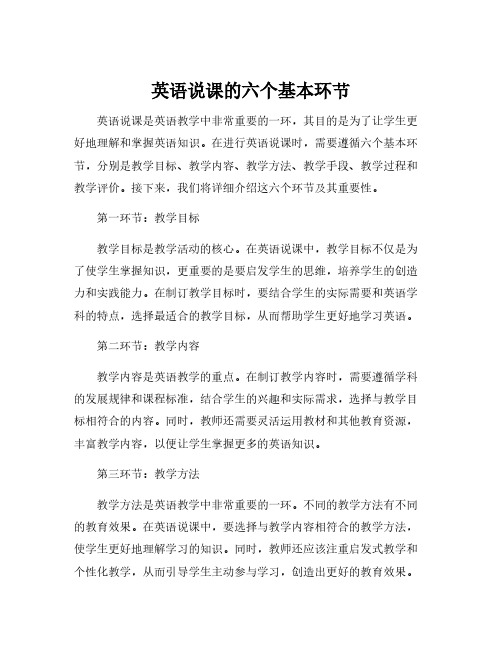
英语说课的六个基本环节英语说课是英语教学中非常重要的一环,其目的是为了让学生更好地理解和掌握英语知识。
在进行英语说课时,需要遵循六个基本环节,分别是教学目标、教学内容、教学方法、教学手段、教学过程和教学评价。
接下来,我们将详细介绍这六个环节及其重要性。
第一环节:教学目标教学目标是教学活动的核心。
在英语说课中,教学目标不仅是为了使学生掌握知识,更重要的是要启发学生的思维,培养学生的创造力和实践能力。
在制订教学目标时,要结合学生的实际需要和英语学科的特点,选择最适合的教学目标,从而帮助学生更好地学习英语。
第二环节:教学内容教学内容是英语教学的重点。
在制订教学内容时,需要遵循学科的发展规律和课程标准,结合学生的兴趣和实际需求,选择与教学目标相符合的内容。
同时,教师还需要灵活运用教材和其他教育资源,丰富教学内容,以便让学生掌握更多的英语知识。
第三环节:教学方法教学方法是英语教学中非常重要的一环。
不同的教学方法有不同的教育效果。
在英语说课中,要选择与教学内容相符合的教学方法,使学生更好地理解学习的知识。
同时,教师还应该注重启发式教学和个性化教学,从而引导学生主动参与学习,创造出更好的教育效果。
第四环节:教学手段教学手段是指在教学过程中,教师用来辅助教学的方法,包括多媒体教学、板书教学、实物教学等。
在英语教学中,教学手段要以学生为中心,注重视觉、听觉、触觉等教学手段的多样性,以便让学生更好地理解和消化所学知识。
第五环节:教学过程教学过程是指在教学中,教师与学生互动,达到教学目标的过程。
在英语说课中,教学过程要重视调整教学节奏和方式,注重启发式引导,引导学生积极参与学习,创造一个良好的教学氛围。
同时,教学过程要注意整个课堂的组织和管理,以确保教学效果。
第六环节:教学评价教学评价是英语教学中重要的一环。
在教学评价时,要根据教学目标和教学内容,选择合适的评价方式和指标,评价教学效果和学生的学习情况,从而不断完善教育教学质量。
英语说课 比赛流程 注意事项
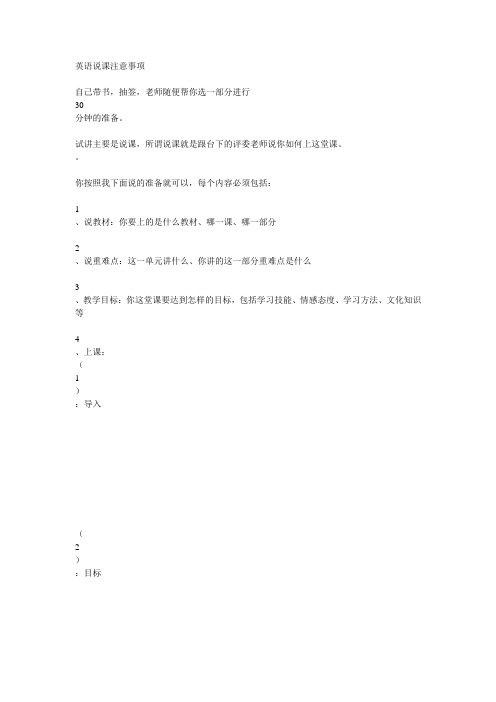
1
、参加测试的人员须携带个人身份证、面试及教学能力测试通知书和测试使用的教材。
2
、测试程序
①参加测试人员必须按通知书规定的时间准时到指定考场的报到室集中。
(待考场负责人布
置测试事项之后,留在报到室等候测试)
②由考场工作人员按各组人员序号,
分批通知测试人员到指定的测试室抽签确定测试课题。
说课包括:
教材所处的地位及作用
教学目标及确定依据
教学重点、难点及确定依据
试讲中考查的重点:
课程资源的开发及有机整合
心理调节的方法指导
知识建构的方法指导
教学方法的选择及依据
灵活教法及促进学生发展的实效性
各种教学手段的合理选择及有效运用
创设问题情景导入、激发兴趣诱发探究
学生主体积极参与、师生关系和谐互动
英语说课注意事项
自己带书,抽签,老师随便帮你选一部分进行
30
分钟的准备。
试讲主要是说课,所谓说课就是跟台下的评委老师说你如何上这堂课。
。
你按照我下面说的准备就可以,每个内容必须包括:
1
、说教材:你要上的是什么教材、哪一课、哪一部分
2
、说重难点:这一单元讲什么、你讲的这一部分重难点是什么
3
、教学目标:你这堂课要达到怎样的目标,包括学习技能、情感态度、学习方法、文化知识等
(六)分值分布
(3)各部分比例为:教材分析20分,教学流程50分,教师语言20分,教师仪态10分。同时要针对自身扬长避短,体现个性(2)要合理安排好15分钟。目标一般2~3分钟要确定下来,
教学设计的基本教学理念,在你的设计中体现了哪些新课标精神?
你的教学整体思路是在什么教育理论支撑下展开的,也就是教学理论依据;
英语课堂教学的5个基本环节有哪些
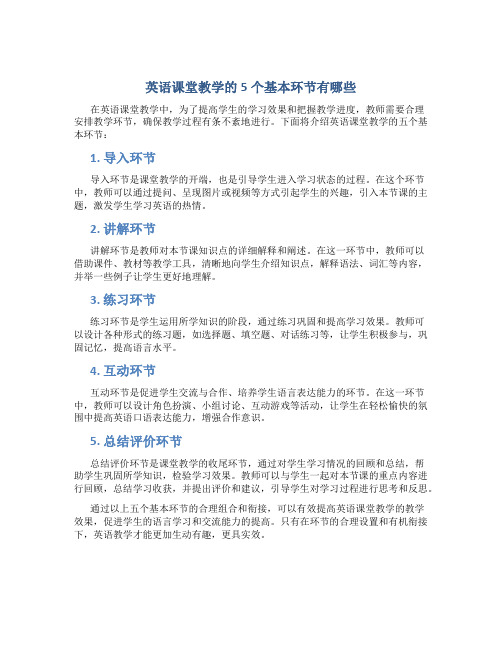
英语课堂教学的5个基本环节有哪些
在英语课堂教学中,为了提高学生的学习效果和把握教学进度,教师需要合理
安排教学环节,确保教学过程有条不紊地进行。
下面将介绍英语课堂教学的五个基本环节:
1. 导入环节
导入环节是课堂教学的开端,也是引导学生进入学习状态的过程。
在这个环节中,教师可以通过提问、呈现图片或视频等方式引起学生的兴趣,引入本节课的主题,激发学生学习英语的热情。
2. 讲解环节
讲解环节是教师对本节课知识点的详细解释和阐述。
在这一环节中,教师可以
借助课件、教材等教学工具,清晰地向学生介绍知识点,解释语法、词汇等内容,并举一些例子让学生更好地理解。
3. 练习环节
练习环节是学生运用所学知识的阶段,通过练习巩固和提高学习效果。
教师可
以设计各种形式的练习题,如选择题、填空题、对话练习等,让学生积极参与,巩固记忆,提高语言水平。
4. 互动环节
互动环节是促进学生交流与合作、培养学生语言表达能力的环节。
在这一环节中,教师可以设计角色扮演、小组讨论、互动游戏等活动,让学生在轻松愉快的氛围中提高英语口语表达能力,增强合作意识。
5. 总结评价环节
总结评价环节是课堂教学的收尾环节,通过对学生学习情况的回顾和总结,帮
助学生巩固所学知识,检验学习效果。
教师可以与学生一起对本节课的重点内容进行回顾,总结学习收获,并提出评价和建议,引导学生对学习过程进行思考和反思。
通过以上五个基本环节的合理组合和衔接,可以有效提高英语课堂教学的教学
效果,促进学生的语言学习和交流能力的提高。
只有在环节的合理设置和有机衔接下,英语教学才能更加生动有趣,更具实效。
综合英语说课文档
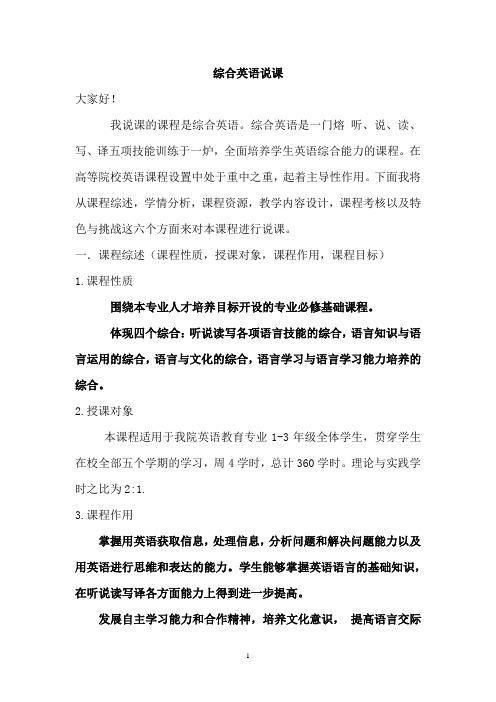
综合英语说课大家好!我说课的课程是综合英语。
综合英语是一门熔听、说、读、写、译五项技能训练于一炉,全面培养学生英语综合能力的课程。
在高等院校英语课程设置中处于重中之重,起着主导性作用。
下面我将从课程综述,学情分析,课程资源,教学内容设计,课程考核以及特色与挑战这六个方面来对本课程进行说课。
一.课程综述(课程性质,授课对象,课程作用,课程目标)1.课程性质围绕本专业人才培养目标开设的专业必修基础课程。
体现四个综合:听说读写各项语言技能的综合,语言知识与语言运用的综合,语言与文化的综合,语言学习与语言学习能力培养的综合。
2.授课对象本课程适用于我院英语教育专业1-3年级全体学生,贯穿学生在校全部五个学期的学习,周4学时,总计360学时。
理论与实践学时之比为2:1.3.课程作用掌握用英语获取信息,处理信息,分析问题和解决问题能力以及用英语进行思维和表达的能力。
学生能够掌握英语语言的基础知识,在听说读写译各方面能力上得到进一步提高。
发展自主学习能力和合作精神,培养文化意识,提高语言交际能力,发展教师职业能力。
4.课程目标1)知识目标通过语言基础训练与篇章讲解分析,使学生逐步提高语篇阅读理解能力,了解英语各种文体的表达方式和特点,扩大词汇量,熟悉英语常用句型,具备基本的口头与笔头表达能力,2)能力目标口语:进行1-2分钟的信息交流,陈述自己的意见和建议听力:听懂关于日常生活和社交的比较浅易的语言材料阅读:读懂英文原著简写本和生词一定的材料和定位关键信息写作:能写一般的应用文、如简历,申请书,求职信等;能写一般的叙述文、描写文、内容摘要、读书报告等3)素质目标了解英语国家的社会与文化概貌,能运用所学知识解决日常学习与工作中遇到的有关文化背景的问题,达到跨文化交际的目的;在英语学习中有较强的自信心,敢于用英语进行交流与表达;在学习中有较强的合作精神,愿意与他人分享各种学习资源;具备一定的英语学习能力二、学情分析及解决方案1. 授课基础,后续衔接学习基础:一定的基础知识,常用词汇,能听懂简单的日常生活和教学用语,一定的阅读能力,基本语法本课程的学习为后续课程(如:英语视听税,英语国家概况,英语翻译,英语写作等)夯实基础。
英语说课稿(共10篇)

英语说课稿(共10篇)英语说课稿(一): 初中英语说课稿精选、说教学程序1.复旧引新阶段.教师和学生进行简单的问候,如:Ss:Good morning,teacher!T:Good morning,class!之后,就上单元的话题和学生展开对话:T:Comrades!We won’t have any lessons this afternoon.I’m going on a field trip.Would youlike to go with meSs:Yes,we do.T:Where are we goingSs:We’re going to the mountains /rivers / hills...T:What do you think we’re going to doSs:We’re going to have a picnic /discuss the air outside...教师可根据当时的情况和学生继续多谈几句,交谈的思维要顺着学生的思维展开.之后,老师问道:T:Do you know what day is tomorrowSs:Yes,we do./No,we don’t.T:Now let me tell you.Tomorrow is Mid-autumn Festival.We’re going to have a big dinner.Would you like to come to my home to eat somethingSs:Yes,we’d love to.到此引出新学课文,教师说:Now let’s learn Lesson9.之后板书“Lesson9”.英语说课稿(二): 新标准初中英语说课稿模板,各位评委X午好!我说课的题目是义务教育课程标准试验教科书《XX》*年级*册第*章确定为本节的重点教学难点:根据(知识**特点、学生已有知识储备或理解能力)确定****为本节难点.根据以上教学目标将详讲***,略讲****,以突出**重点和突破难点二、说教法:根据以上教材分析,为促进学生的**能力发展,对****知识将采用***教法,为落实重点采用**教法;为突破难点采用**教法;等等.(注重启发式、讨论式,实现因材施教)三、说学法:为使所学知识能较好的纳入学生已有的知识体系,促进学生的智能发展,对**知识将分别采用(材料分析法、读图发现法、归纳总结法等等)为落实教学目标将着重做好以下练习:对****知识通过填空、连线、材料、表格、选择、读图等进行训练四、教学过程:1、(创设情景、激发兴趣、复习回顾等),导入新课通过****来(创设情景、激发兴趣、复习回顾等)导出本节课所学知识,板书课题2、(导学结合、图文研习、探究发现等),讲授新课注意:a各步骤清晰流畅b用多媒体时语言是:媒体展示(材料、地图、练习等)c学生活动和教师活动明确,活动说明意图(围绕三维目标)d框题间要有过渡语言e有创新的做法着重说f告诉评委:以上是我的板书设计(条理、知识主干、创新不是简单的知识点排列)3、课堂小结:(回顾小结、指板书小结、媒体展示脉络小结、学生自我小结等),并指出重、难点.4、巩固练习:(此步有无可根据教学过程调节)5、作业设置:以上是我的说课内容(或说课完毕),谢谢各位评委!英语说课稿(三): 求一篇好的,小学英语说课稿Good morning,everyone!Today,I’ll say something about Unit 9 Part A in Book 4 of Oxford English.Background on the reformation of curriculum,this book can connect the life and act,emphasize the interest and experience of the Ss,the pictures are active and vivid.Grade four is the initial stage of English learning,so it stresses on the emotion of the Ss,creates a well beginning for the Ss.This Unit has 7 parts,we’ll learn Part A mainly,it embodies the repeating characterize.Review the learned language points “Where’s…”and the new language points will be represented in the following units.So this unit forms connectinglinks with a special meaning in this book.The content of thi s period is to use “Where’s\are…” to determine the place.And according to the contents and the fact of the Ss,I establish the following three teaching aims of this period:The first one:students can listen,read,say and spell the following words:a glass,a fridge,an egg,bread and a table.The second one:students can listen,read,say and write the following daily expressions:What’s for breakfastHave some juice then.The third one:students can listen,read,say and write the following sentence pattern s:Where’s\Where are the\my…It’s \They’re…There’s no …in \on \near…I think the most difficult point of this period is to make sure the students can use the patterns “Where’s\Where are…and There isno …in\on\near…” in their daily life correctly.And I will use some pictures,words and sentence cards,a tape recorder and the multi-media computer to help me achieve the aims. The task-based method,communicated method,group cooperate method will be used in this period.To accomplish the aims,I design the following steps:Step 1 Songs and the game arousers the emotion.In order to attract the Ss’ attention and construct an atmosphere of learning English,I let the students sing some English songs and play the game “Simon says”.At the same ti me the game can review the prep,serve the knowledge as foil and consist the appearance of the knowledge.Step 2 Change class to life,happy to say.The substance of language is communication and the environment of communication is life.So when I present the sentence pattern “What’s for breakfast” I first show a clock to elicit the time for breakfast,teach the sentence.Then show my own photo of having breakfast,Ss ask and guess.In this way I can attract Ss’attention,encourage Ss to ask Qs with the new knowledge.Most of the Ss have learnt the sentence pattern:Where’s…so I design a task for Ss to help Helen find the food and drinks forbreakfast,and teach the new language points:Where are…They’re … Meanwhile stick the sentences on the Bb.After some practice by asking and answering,I present the next language points:There’s no …in\on\near…Have …then.And I will stick these sentence patterns on the Bb.Finally I’lllet the Ss do pair works to consolidate them.Step 3 Listen to the tape and Ss imitate to read and say.As the new reformation of curriculum,emphasized the traditional class attach importance to the mechanical teaching,neglect the experience and participation,for example,the five-step method.So in this lesson,after presentation,I ask Ss to listen to the tape with three Qs,read in different roles and in pairs,then try to recite the text.Step 4 Ss be the main body,T makes a guider.In class,Ss play as a host,and the T makes an influence on guiding,help Ss to act the learnt dialogue,it can stress the position of the Ss,and arouse their interest.Then I show a carton with no voice,ask Ss to make a dialogue in pairs.There are lots of ways to consolidate the new knowledge.Playing game is a good way.So according to the physiology of Ss,I hold a group competition during the game,ask Ss to finish the blanks.In this way can develop Ss’ good habits and achieve the aim of mastering the learned knowledge in situation.Step 5 Change class to life,learn by themselves.Is t his the end of the classI don’t think so.If there is an end,Ithink it should be in the life.So I extend this class,encourage Ss to use the learned to communicate with each other in their life.In a word,the whole period is based on tasks,which are designed from easy steps to steps that are challenging.When the Ss are carting out the tasks,they can acquire information,knowledge,and have their ability and skills trained.That’s all.Thanks a lot for your attention.英语说课稿(四): 英语教师如何撰写说课稿所谓说课,是指在某一特定的场合,教师较为系统地讲述某一教学内容的课堂教学设计及其设计的理论依据.说课分详细说课和概略说课.一、英语说课讲稿的要素及撰写方法英语说课讲稿也包括五个要素:说教材、说教法、说学法、说教学程序、说板书设计.(一)说教材说教材要对教材所在的知识系统做简要分析,通过分析某课教学内容在整个教材体系中的作用,以及本课教学内容与学生先前掌握的知识和将要学习的知识的联系,说明教材的地位和作用;通过对课程标准关于教学的具体要求的概括分析,说明本课教学目标的确立及其依据;通过对英汉两种语言差异和学生的知识水平的简要分析,确定并说明重点、难点和关键点的确立及其依据.1.说教材的地位和作用.说教材的地位和作用,应简要分析本课内容在单元整体教学中和整个教材体系中甚至在素质教育英语教学中的重要地位.例如,在分析SEFC Bl L37的教材地位和作用时可做如下表述.SEFC Bl L37是对话课,对话课是单元整体教学的重要环节.作为单元的第一课,对话课的作用首先是为第二、三课提供话题和语境.由于整个单元都是围绕一个话题操练特定的功能项目,对话课又具有为二、三课的学习扫清语言和文化障碍的作用.本课对话内容紧紧围绕体育运动话题展开,谈论运动项目必定使人联想到奥运会、奥运历史、奥运精神等,这就为下一课阅读教学提供了话题和语境.本课操练的功能项目是表达个人喜好的句型"prefer...to",学习并熟练掌握该句型有助于学生能就"prefer A to B”表达自己对运动项目的爱好及爱好程度.从素质教育的要求和学习语言的目的看,高中英语教学重视培养学生运用英语进行交际的能力.根据英语课程标准的要求,对话课应侧重培养学生的口语表达能力,体现英语教学的交际性、得体性、准确性和实践性.因此,本节对话课教学应着重培养学生熟练运用所学功能用语谈论体育话题的能力,为进一步自由谈论奥运历史打下基础.2.说教学目标的确立及其依据.教学目标的确立首先要根据单元教学的目的和要求(对语音、词汇、日常交际用语、语法等方面的不同程度的要求),结合学生的实际水平,确定贯穿单元教学的总目标(goal).总目标可以是相当概括的,如SEFC Bl L37的总体教学目标可定为“了解奥运会历史,学习表达个人爱好的交际用语".一节课的教学目标(objective)则应落实到与本课教学内容相关的具体语言知识或某项技能上,即:通过本节课的教学,重点解决什么问题(知识和能力),达到什么样的要求.为了贯彻“寓思想教育于语言教学之中"的教学原则,教师还要深入挖掘教材的德育因素,从而确定德育(情感情意)目标.教学目标的表述要准确、具体、简洁、全面,要明确写出本节课的知识目标、能力目标和德育目标.如,JEFC B3 L82的教学目标可表述如下.(1)知识目标:学习和掌握过去完成时;总结和归纳有关购物用语;复习衣服的名称、颜色、大小等词汇.(2)能力目标:通过听录音,掌握正确的语音、语调,使学生形成良好的语言习惯;通过学生间的提问和回答,激发学生学习的积极性和主动性;同时在阅读过程中,注意发展学生的逻辑思维能力.(3)德育目标:通过购物的学习和问答,使学生注意和学习在交际中的礼貌行为(寓思想教育于语言教学之中).3.说重点、难点和关键点的确立及其依据.说课稿要写出该课的重点、难点和关键点分别是什么,并写出确立该重点、难点和关键点的理论依据,即在列举该课重点、难点和关键点的同时,说明为什么该重点是本课教学的最主要部分或最重要内容,为什么该难点在本课教学中是学生最难理解和最容易出现错误的部分(有时重点和难点相同),为什么该关键点对本课教学的成败起决定性的作用.例如,JEFC B3 L2l说重点、难点、关键点及其依据可表述如下.(二)说教法说教法至少要说明选择使用何种教学方法,以哪种教学方法为主,哪几种方法为辅,采用什么教学手段实现教学目标,采用这些教学方法和手段的理论依据是什么,并说明这些教学方法在本课教学中的具体操作方法.说教法时最好能说明在本课教学过程中贯彻什么教学原则,采用什么教学模式,并做出必要的解释和说明.如果巳形成了独特的教学思想和教学特色,最好单独列出.例如,SEFC Bl L37的说教法可表述如下.英语说课稿(五): 英语说课的基本步骤【英语说课稿】本课的总体思路(目标、要点、巩固)如何开始这堂课如何进入这堂课如何让学生学以致用如何总结英语说课稿(六): 求初中英语语法说课稿-全英文版Good afternoon, everyone. I’m Zhou Yan. I’m an English teacher from Experimental School of Suqian. Now I’ll say Sample A of Lesson Six in Book One. I’ll prepare to say the lesson from four parts. Part One Analysis of the Teaching Material(一) STATUS AND FUNCTION1.This is an important lesson in Book One. From this lesson, it starts asking the Ss to grasp contents of each Sample. To attain “four skills” request of listening, speaking, reading and writing. To start listing “Word Bank” and tell the Ss to remember the new words. To start asking the Ss to write English sentences well. Therefore this lesson is in the important position of the teaching material.2.This lesson is the first one of Unit 2.So if the Ss can learn it well, it will be helpful to make the Ss learn the rest of this unit.3.Such a topic is related to daily life, so it is helpful to raise learning interests of students and it will be also helpful to improve their spoken English.(二)ANALYSIS OF THE STUDENTSThe Ss has learned English for about one month so far. They can understand some words and some simple sentences. The Ss have taken a great interest in English now.(三)TEACHING AIMS AND DEMANDSThe teaching aim"s basis is established according to Junior School English syllabus" provision.1.Knowledge objects(1) To make the Ss know how to use the affirmative sentence “Th is is. . . .” and the negative sentence “This is not….”Everyday expressions for “Apologies”“I\"m sorry”“That\"s all right”. (2) To study the new words “six, hey, sorry, it’s, that’s”, etc. by learning the dialogue of this lesson.(3) To finish some exercises.2.Ability objects(1) To develop the Ss’ abilities of listening, speaking, reading and writing.(2) To train the Ss’ ability of working in pairs.(3) To develop the Ss’ abilities of communication by learning the useful structures.3.Moral objects(1) To enable the Ss to be polite and love life.(2) To enable the Ss to look after their things well.(四)TEACHING KEY AND DIFFICULT POINTSThe teaching key and difficult points’ basis is established according to Sample A of Lesson Six in the teaching material\"s position and function.1.Key points:(1).To help the Ss to communicate with each other.(2).To enable the Ss to study in groups and co-operate skillfully.(3).To develop the Ss’ interest in Eng lish.2.Difficult points:(1) How to make dialogues and act them out.(2) How to write the right whole sentences.(五) TEACHING AIDSMulti-media computer, Tape recorder, Software: Powerpoint or Authorware, school things and so on. They will be needed in this lesson.Part Two The Teaching Methods1. Communicative teaching method2. Audio-visual teaching method3. Task-based” teaching methodAs we all know: the main instructional aims of learning English inthe Middle Sc hool is to cultivate students’ abilities of listening, speaking, reading, writing and their good sense of the English language. So in this lesson I’ll mainly use “Communicative” teaching method, “Audio-visual” teaching method and “Task-based” teaching meth od. That is to say, I’ll let the Ss to get a better understanding of the key structure of the dialogue. I’ll give the Ss some tasks and arrange five kinds of activities: talking, guessing games, watching CAI, acting out Sample A and having a competition. Teaching special featuresTo use these methods are helpful to develop the Ss’ thought.Part Three STUDYING WAYS1.Teach the Ss how to be successful language learners.2.Let the Ss pass \"Observation—Imitation—Practice \" to study language.3.Teach the Ss how to master dialogues and how to communicate with others.Teaching special features:Let the Ss communicate with each other and adopt competition methods to develop the Ss’ keen interest in English.Part Four Teaching ProcedureI’ll finish this lesson in four steps. First I’ll divide the Ss into four groups and bring a competition into the class. At lastlet’s see which group is the winner.Step1 Warm-up1. Free talk between T and Ss .Such as: Hi, I’m . .. . What’s your nameThis is …. How do you doWho is he/she How are youWho can count from 1to 5What’s this in English etc.2.A game: Ask the Ss to give T some school things. For example: T: Give me your book.(ruler, box, pen, table, knife, etc.)T: This is your book. This is not my book. It’s your book. etc. In this course I’ll ask them to make a dialogue group by group without repetition. Find out which group will make the most dialogues.Purpose of my designing: I think it is important to form a better English learning surrounding for the Ss by imitating and at the same time it is necessary to provide situations to review learned knowledge.Step2. PresentationThis course is very important. I’ll mainly talk ab out this step. I’ll use CAI to present the whole dialogue. Arrange somesituations to help Ss understand Sample A.First scene: There is a bag on the floor. B is picking it up and get ready to leave. Now A is talking with B.A: Hi, B. How are you todayB: I’m fine, thank you. And youA: I’m fine, too. Oh, this is my bag.B: No, this is not your bag. It’s my bag.A: (Look closely) Oh, I’m sorry.B: That’s all right.(At the same time, C is running up and hitting A.)C: Oh, I’m sorry.A: That’s OK.I’ll write the key points on the Bb while they are watching. Afterwatching, I’ll teach them to read the words and sentences on the Bb. Make sure they can read them well.Purpose of my designing: To present Sample A by CAI is much easier for the Ss to learn and grasp the meanings. CAI can provide a real situation with its sound and picture and it makes the relationships between the Ss better.Step3.PracticeFirst play the tape recorder. Let the Ss listen and imitate the dialogue. Pay attention to their pronunciation and intonation. Inthis step the Ss are required to practise the Sample in pairs by reading the dialogue aloud. This step is employed to make the Ssgrasp the Sample .At last I’ll ask the Ss to th ink hard and act it out with a partner according to Sample A. Then find out which group will act it out well. I’ll give them red stars.Purpose of my designing: This step is employed to make the Ss get the general idea of the dialogue as a whole one. At the same time let the Ss have a chance to practise their listening and spoken ability. Step4.ProductionIn this step I’ll give the Ss a free space to show theirabilities.Second scene: The Ss are having a picnic. It’s hot and they takeoff their coats and put them together. They are singing and dancing, laughing and chatting. After the picnic, they begin to look for their coats. D and E are talking. F and G are talking. etc.After watching, I’ll give the Ss some tasks to make similar dialogues without repetition and find out which group will make more dialogues.Purpose of my designing: “Task-based” teaching method is usedhere to develop the Ss’ ability of communication and also their ability of co-operation will be well trained. Tell the Ss we should be polite and take good care of our things. We should love our life.I think proper competition can arouse the Ss’ interest in English learning. If the Ss can finish this task well, they will benefit alot in their spoken English.2.Skill 1 Model 1.I’ll ask four Ss of the groups to write these sentences on the Bb in the four lines.Then check their handwriting, correct their mistakes. Find out who will write well and whose handing is the best.3.Finish the Ss’ workbook.Purpose of my designing: To check the knowledge Ss have learned in this lesson.Step5.Homework:(1)Recite the words as many as possible after class.(2)Make a dialogue according to Sample A and write it in the exercise book.Purpose of my designing: I think homework is so important that the Ss should speak English as much as they can in class or after class. It is necessary for the Ss to do some extensive exercises after class to consolidate the knowledge they learned.Blackboard DesignLesson Six Sample ASix This is my….hey This is notyour. . . .sorry It’s my. . . . Picture it’s=it is Oh, I’msorry.that’s=that is That’s all right/OK.【英语说课稿】英语说课稿(七): 高一英语说课稿是要全英文的还是中文的最好是中英文穿插在一起的全英文学生会跟你没什么互动全中文的听课的老师和学生可能又会觉得你水平有限英语说课稿(八): 求一两篇小学英语试讲稿和说课稿My FamilyI have a happy family . I am the only child in my family.My father is thirty-two years old. He is 170cm in height. He is a farmer and he often works hard in the field from morning till night. When my father is free , he will go to find another job to make more money. My mother is a housewife . She does housework every day.I am a sunny girl . My name is He Hua. I like growing flowers andI look after them with my parents .I love my family.英语说课稿(九): >>[转]怎样写小学英语说课稿(全英文的)它是整个模块的重点,占有很重要的地位,它为后两个单元的学习奠定了基础.2.教学目标知识目标:学习掌握单词 football. basketball. table tennis. morning exercise,学习运用句型I like …\I don"t like ….能力目标:培养学生运用英语的能力.德育目标:教育学生热爱体育运动,勤于体育锻炼.确立教学目标的依据:根据《英语新课程标准》的要求,小学阶段的英语课主要是激发学生学习英语的兴趣;培养学生对英语学习的积极态度,使他们建立学习英语的自信心;培养学生一定的语感和良好的语音、语调,为英语的进一步学习打下基础.3.教学的重点与难点教学重点:能听说单词 football. basketball. table tennis. morningexercise,运用句型I like …\I don"t like ….教学难点:灵活运用句型I like …\I don"t like ….确立教学重难点的依据:根据《英语新课程标准》的要求以及本课在教材中所处的地位和作用.英语说课稿(十): 英文说课的步骤需要说哪几大块我是去参加英语说课比赛,是求职面试用的吧.学校会先给定说课的范围,给10分钟左右的准备时间.说课其实就是讲讲你如何将给定的文章展开来讲给学生听,所以突出的是你的讲课的构想和思路,而不是具体的语法点等等的内容.说课一般是精读课文,所以可以从突出以下几部分来讲:1.文章的创作背景,作者简介;突出文章时代特点(以提问回答的方式.)2.文章主要涉及的语法现象(以归纳总结的方式.)3.文章的主要词汇(以举例的方式)4.课堂总结5.课后作业因为说课说的是一堂课的安排,所以预习、学习、练习、复习、作业各个部分要完整.说课是把听众定位为老师、评委;讲课是把听众定位为学生.但是现在一般学校面试的时候不是特别区分讲课和说课的,通常情况下是连说带讲的.而且还会有提问回答的环节,问题内容可能会涉及自己的研究领域、论文、兴趣所在等等的.所以不能轻视啊!加油,初中英语说课稿小学英语说课稿。
英语课程的六要素
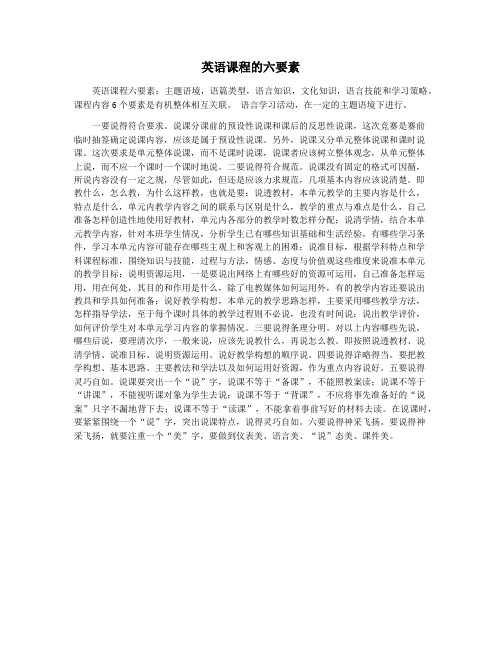
英语课程的六要素英语课程六要素:主题语境,语篇类型,语言知识,文化知识,语言技能和学习策略。
课程内容6个要素是有机整体相互关联。
语言学习活动,在一定的主题语境下进行。
一要说得符合要求。
说课分课前的预设性说课和课后的反思性说课,这次竞赛是赛前临时抽签确定说课内容,应该是属于预设性说课。
另外,说课又分单元整体说课和课时说课。
这次要求是单元整体说课,而不是课时说课,说课者应该树立整体观念,从单元整体上说,而不应一个课时一个课时地说。
二要说得符合规范。
说课没有固定的格式可因循,所说内容没有一定之规,尽管如此,但还是应该力求规范,几项基本内容应该说清楚。
即教什么,怎么教,为什么这样教,也就是要:说透教材,本单元教学的主要内容是什么,特点是什么,单元内教学内容之间的联系与区别是什么,教学的重点与难点是什么,自己准备怎样创造性地使用好教材,单元内各部分的教学时数怎样分配;说清学情,结合本单元教学内容,针对本班学生情况,分析学生已有哪些知识基础和生活经验,有哪些学习条件,学习本单元内容可能存在哪些主观上和客观上的困难;说准目标,根据学科特点和学科课程标准,围绕知识与技能,过程与方法,情感、态度与价值观这些维度来说准本单元的教学目标;说明资源运用,一是要说出网络上有哪些好的资源可运用,自己准备怎样运用,用在何处,其目的和作用是什么,除了电教媒体如何运用外,有的教学内容还要说出教具和学具如何准备;说好教学构想,本单元的教学思路怎样,主要采用哪些教学方法,怎样指导学法,至于每个课时具体的教学过程则不必说,也没有时间说;说出教学评价,如何评价学生对本单元学习内容的掌握情况。
三要说得条理分明。
对以上内容哪些先说,哪些后说,要理清次序,一般来说,应该先说教什么,再说怎么教。
即按照说透教材、说清学情、说准目标、说明资源运用、说好教学构想的顺序说。
四要说得详略得当。
要把教学构想、基本思路、主要教法和学法以及如何运用好资源,作为重点内容说好。
小学英语说课一般八个部分都包括什么

小学英语说课一般八个部分都包括什么
是在备课的基础上,面对同行或专家领导,在规定的时间内,针对具体课题,采用讲述为主的方式,系统地分析教材和学生等,并阐述自己的教学设想及理论依据,然后由同行评议,达到互相交流,共同提高的一种教研活动。
说课的作用:
说课其实也是一种集体备课的形式,是为了提高课堂教学效率,教师之间进行的一次思想碰撞,一次智慧的交流。
说课基本方式是,参赛教师针对某一特定的教学内容,向同行或考评人员系统地阐述自己对教学内容的处理、学情的分析以及教学策略的设计等。
说课活动要求教师在较短的时间内(一般为8-10分钟)讲清“教什么”、“怎么教”,以及“为什么这样教”之类的教学问题,通过说课,教师能高屋建瓴地把握教材,预设学习中的各种“教学事件“,反馈教学中的得失,选择适宜的教学方法,提高课堂教学效率,促进教学研究。
说课的环节主要包括:
一、说教材,说教材的内容和地位,本节课知识点的前后联系。
二、说学生,分析学生的知识水平和认知特点,本节课的学习困难点等。
三、说教学目标(三维)和重难点,根据上面的分析确定教学目标和重点、难点。
四、说教法,本节课教学所采用的教学方法及依据。
五、说学法,本节课指导学生自主学习所采用的方法。
六、说教学过程,具体说各个教学环节,环节设置的意图,可能出现的情况,教师的处理方法。
七、说板书设计,不用多解释了。
八、说反思,如果是上完课后的说课,还要有根据上课的具体情况进行的教学反思,主要是好的效果,不足,改进设计等。
(课前说课不需要,课后说课需要。
)。
英语课堂教学的六个环节时间分配是什么

英语课堂教学的六个环节时间分配是什么英语课堂教学是学生学习英语的重要环节之一,良好的时间分配是保证课堂教学质量的关键因素。
在英语课堂教学中,通常会包括六个环节,每个环节都需要合理安排时间,以确保教学内容的有效传达和学生的充分参与。
环节一:热身活动(Warm-up)热身活动是英语课堂的第一个环节,通过各种趣味性的活动吸引学生的注意力,激发学生学习英语的兴趣。
通常建议将热身活动的时间控制在5到10分钟之间,不宜过长,以免耽误后续教学内容的展开。
环节二:导入(Introduction)导入环节主要是对本节课的主题进行引入,让学生对将要学习的内容有一个整体的把握。
在导入环节中,教师可以通过提问、展示图片或视频等方式引起学生的注意,激发学生的思考。
建议将导入环节的时间控制在5到8分钟,不宜过长。
环节三:教学(Teaching)教学环节是英语课堂的核心部分,教师通过讲解、示范、练习等方式向学生传授知识和技能。
在教学环节中,教师需要控制节奏,让学生积极参与,确保教学内容的准确性和有效性。
建议将教学环节的时间控制在15到20分钟之间,根据具体内容的难易程度适当调整。
环节四:练习(Practice)练习环节是学生巩固和应用所学知识的重要环节,通过练习可以帮助学生提高英语应用能力。
在练习环节中,教师可以设计各种练习题目,让学生进行口头或书面练习。
建议将练习环节的时间控制在10到15分钟之间,以保证学生有足够的时间进行练习。
环节五:总结(Summary)总结环节是对本节课内容的回顾和总结,让学生对所学知识有一个系统的梳理。
在总结环节中,教师可以鼓励学生分享自己的学习体会,澄清学生对知识点的疑惑。
建议将总结环节的时间控制在5到8分钟,不宜过长。
环节六:作业布置(Homework Assignment)作业布置环节是对学生提出作业要求,让学生在课后进行巩固和练习。
在作业布置环节中,教师需要清晰明确地告知学生作业要求和截止时间,并鼓励学生认真完成作业。
英语教研---如何说课 讲课 听课 评课

如何说课讲课听课评课一、说课(一)说课要求“六说”:即说课标、说教材、说学生、说教法、说训练、说程序。
课标是教学的依据,教材特点和学生情况既是教学的出发点,又是教学的归结点。
教法是根据教材的特点和学生的情况而选择的,是达到教学目标的手段;训练包括课内的和课外的,是培养学生能力的途径;程序则是优化教学过程和优化课堂结构的教学方案。
“六说”构成说课的整体内容,也构成课堂教学的全过程。
(二)、“六说”的具体要求1、说课标主要说两点:(1)所选课题在本科教学中的地位和作用。
这要依据课标所规定的教学原则和要求,在整体把握教材知识体系和编写意图的前提下,通过分析新选课题(章、节、课)内容特点,确定其在整体或单元教学中的地位。
通过分析新旧知识的联系,确定其在整体或单元教学中的作用。
(2)根据“地位”和“作用”,制定本课题的学习目标,通常从三方面来制定:A、思想教育目标①思想政治教育——如“五爱”教育,历史唯物主义,辩证唯物主义教育,道德品质教育等②学习品质教育——非智力因素的培养,如毅力、态度、方法、习惯等③思维品质教育——各学科有其独特的思维方式和特点,需要通过教学来培养学生良好的思维品质。
数学——等价转换,数形结合,分类讨论;语文——学习与生活相结合;英语——交际能力。
B、知识传授目标主要指各学科的基础知识,基本理论、基本技能的教学目的和要求。
C、能力形成目标记忆什么,理解什么,掌握什么,动用什么,评价什么,综合什么,在课标中要有明确的要求。
2、说教材主要说对教材内容的理解,分析和处理,包括理论上的理解,知识点的解析。
重点。
难点的确定和解决。
分析教材是常规备课的重点,也是说课的重要内容,但说课更要侧重说明处理教材的理论依据和采用的处理方法,而不对某些具体知识作更多的解释和说明。
如语文的解释词义,归纳段意,数理化的概念,定理的解释等。
3、说学生主要是分析学情,如学生的原有基础,学习本课题的有利因素和存在的问题,上、中、下三类学生的分别,以及学法指导等。
英语大赛说课稿范文模板

英语大赛说课稿范文模板尊敬的评委老师,各位同学,大家好!今天,我有幸在这里与大家分享我的英语教学理念和方法。
我将从教学目标、教学内容、教学方法、教学过程、评价方式以及教学反思六个方面,对即将进行的英语课程进行说课。
一、教学目标本节课的教学目标是让学生掌握一定数量的英语词汇和基本句型,提高他们的英语口语表达能力,同时激发他们学习英语的兴趣。
二、教学内容本节课的教学内容主要包括以下几个部分:日常用语的学习、简单对话的练习、以及英语文化背景的介绍。
三、教学方法为了达到教学目标,我将采用情景教学法、任务型教学法和合作学习法。
情景教学法可以让学生在模拟的语境中学习语言,任务型教学法则通过完成具体的任务来提高语言运用能力,而合作学习法则鼓励学生之间的交流与合作。
四、教学过程1. 导入新课:通过播放一段与本节课主题相关的视频,激发学生的兴趣,并引入新课的主题。
2. 词汇教学:通过图片、实物和动作演示,教授新词汇,确保学生能够正确发音和理解词义。
3. 对话练习:设计情景对话,让学生在小组内进行角色扮演,练习使用新学的词汇和句型。
4. 文化介绍:简要介绍与本节课相关的英语国家文化,拓宽学生视野。
5. 课堂小结:总结本节课的重点内容,鼓励学生进行自我反思。
五、评价方式本节课的评价方式将包括课堂表现、小组合作情况、以及课后作业的完成情况。
通过多元化的评价方式,全面了解学生的学习效果。
六、教学反思课后,我将根据学生的反馈和课堂表现,对教学方法和内容进行反思和调整,以期达到更好的教学效果。
最后,我相信通过本节课的学习,学生们不仅能够学到实用的英语知识,还能够提升自己的跨文化交流能力。
谢谢大家!(结束语)再次感谢各位评委老师和同学们的聆听,我期待与大家共同探讨和进步。
谢谢大家!。
英语说课稿范文

英语说课稿精选范文一、说课目标本节课主要教授英语中第一次学习动词过去式的内容。
通过这节课,学生将能更好地理解并掌握英语中动词过去式的构成规则及其使用方法。
具体的学习目标包括:学习动词过去式的构成方法,能运用正确的动词过去式进行口语交流,理解一些特殊动词的过去式形式,并能使用它们正确地表达自己的意思。
二、说课内容1、导入环节在这个环节中,我会给同学们提出一个问题——“你最近过了什么美好的周末?”让同学们口语交流一下。
这样不仅可以帮助学生更快速地进入英语口语的状态,同时也可以增强课堂互动。
这个问题2、语言知识学习在这个环节中,我会对动词基本形式的构成进行简单的讲解。
接着,会分别介绍正规动词、“e”结尾动词、“y”结尾动词和一些特殊动词(如av兹能、be、do、go等)过去式的构成和变化规则。
同时,我会通过多个例句,让学生能够对所学内容有更好的理解和记忆。
3、口语运用练习在这个环节,我准备了一些口语练习内容,并将学生们分成小组,让他们在组内互相进行口语练习,同时我也会在课堂中进行引导和点拨。
这样,学生们可以更快地提升英语口语能力,并更好地掌握动词过去式的使用方法。
4、课堂总结在课堂结束前,我会对今天的学习内容进行总结,并鼓励学生们要多加练习,努力掌握所学内容。
三、教学难点本节课的教学难点主要在于特殊动词(如do、go、be等)的过去式形式,这些动词过去式的构成具有一定的规律性,但同时也存在一些例外情况,这些例外情况需要进行重点讲解和强化训练,以便学生能够更好地理解和记忆这些内容。
四、教学重点本节课的教学重点主要包括动词过去式的构成规则及其使用方法,这是英语语法知识的基础,学生必须要从基础学习起,才能更好地掌握英语。
五、教学方法在教学中,我主要采用互动式教学与合作式学习的方法,通过让学生们参与口语练习、小组讨论等教学方式,来提高课堂效率与学生的学习兴趣。
六、板书设计本节课的课堂板书主要包括动词过去式的构成规则及其使用方法,其中包括正规动词、e结尾动词、y结尾动词和特殊动词的过去式变化规律。
初中英语说课稿的基本步骤六步
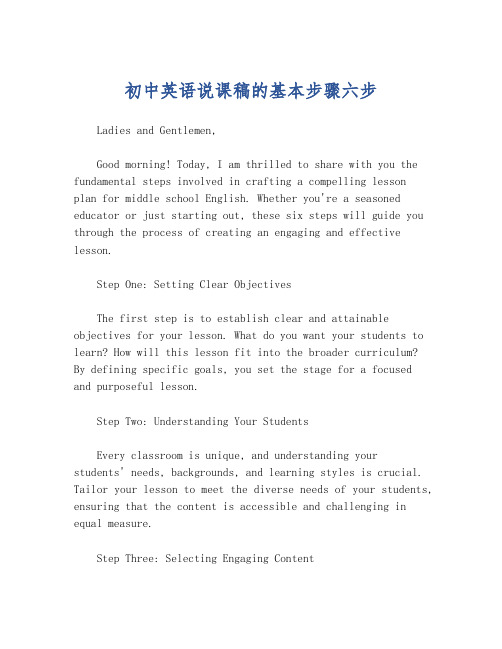
初中英语说课稿的基本步骤六步Ladies and Gentlemen,Good morning! Today, I am thrilled to share with you the fundamental steps involved in crafting a compelling lessonplan for middle school English. Whether you're a seasoned educator or just starting out, these six steps will guide you through the process of creating an engaging and effective lesson.Step One: Setting Clear ObjectivesThe first step is to establish clear and attainable objectives for your lesson. What do you want your students to learn? How will this lesson fit into the broader curriculum? By defining specific goals, you set the stage for a focused and purposeful lesson.Step Two: Understanding Your StudentsEvery classroom is unique, and understanding yourstudents' needs, backgrounds, and learning styles is crucial. Tailor your lesson to meet the diverse needs of your students, ensuring that the content is accessible and challenging in equal measure.Step Three: Selecting Engaging ContentContent is the heart of any lesson. Choose materials that are not only relevant to your objectives but also captivating. Engaging content can transform a mundane lesson into an unforgettable experience.Step Four: Designing Interactive ActivitiesInteractive activities are the key to student engagement. Design activities that encourage participation, collaboration, and critical thinking. Whether it's a group discussion, arole-play, or a creative writing exercise, make sure every student has the opportunity to actively engage with the material.Step Five: Incorporating AssessmentAssessment is not just about testing; it's about understanding how well your students have grasped the material. Incorporate formative assessments that providereal-time feedback, allowing you to adjust your teaching approach as needed.Step Six: Reflection and RevisionThe final step is to reflect on the lesson. What worked well? What could be improved? Use this reflection to revise and refine your lesson plan for future use. Remember,teaching is a dynamic process, and continuous improvement isat the core of effective pedagogy.In conclusion, these six steps form the backbone of awell-structured middle school English lesson plan. By focusing on objectives, understanding your students,selecting engaging content, designing interactive activities, incorporating assessment, and reflecting on the lesson, you can create a learning environment that is both challenging and inspiring.Thank you for your attention, and I look forward to any questions you may have.。
三步六环节说课稿

构建英语“三步六环节”课堂教学模式初探天堂学校汤秀一、“三步六环节”课堂教学模式形成的背景面对教育改革新形势,我校的课堂教学改革也在不断推进中。
近几年,在上级领导的关怀和指导下,学校把“深化课堂改革,打造高效课堂”定为教学工作的首要任务。
根据学校教研工作安排,我们英语教研组经过几年的教学实践,结合本校的实际,明确提出了构建英语“三步六环节”课堂教学模式的初步设想与实施方案。
二、“三步六环节”的总体设计“三步六环节”——三步即,课程导入,新知展示,巩固练习。
六环节是趣味热身,巧妙导入,新课呈现,巩固操练,有效检测,拓展提高。
三、“三步六环节”课堂教学模式的实质全过程让所有学生参与到课堂教学中学习。
课堂教学的整个过程始终遵循着两条线:一条是学生的学习、合作、探究、练习,这是明线;另一条是教师适时的和必要的要求、指导,这是暗线。
“三步六环节”课堂教学模式的特色还体现在它对于“学”、“教”、“练”三者的交叉的、循环的、整体的时间安排上,真正实现了学生的主体地位和教师的指导作用的双向融合,真正把教学过程变为学生自己获得信息、掌握技能、形成态度的过程。
全面发展了学生素质,提高了课堂教学质量。
四、“三步六环节”的具体操作【第一步】课程导入第一个环节----趣味热身。
英语课前的热身活动用英语说是“Warming up ”,又可以称之为导课。
是指在课前通过学生唱英文歌曲、做英语游戏、猜谜语、讲故事等各种活动,了解学生的出勤情况、课前准备是否到位、是否为上英语课做好了思想上和语言上的准备等,有意识缩小师生之间的距离,创设良好的英语课堂氛围,为有效开展教学活动进行一个良好的情绪铺垫。
同时教师也可以在较短的时间里调动起学生的积极性,吸引学生的注意力,使同学思维进入兴奋状态,迅速进入学习轨道,是教学胜利与否的关键,因此课前几分钟的导课是课堂教学的重要前奏。
第二个环节----巧妙导入。
如何从上节课向本节课的自然过渡是每位教师都必须考虑的技巧,因此导入是教学过程中最基本的也是非常重要的第一步。
- 1、下载文档前请自行甄别文档内容的完整性,平台不提供额外的编辑、内容补充、找答案等附加服务。
- 2、"仅部分预览"的文档,不可在线预览部分如存在完整性等问题,可反馈申请退款(可完整预览的文档不适用该条件!)。
- 3、如文档侵犯您的权益,请联系客服反馈,我们会尽快为您处理(人工客服工作时间:9:00-18:30)。
英语说课的六个基本环节IntroductionHello everyone! Today, I am going to give a talk on English lesson planning. As we all know, lesson planning is an essential part of teaching process. The purpose of a lesson plan is to provide a structure for teachers to deliver content effectively and efficiently. In order to develop a good lesson plan, there are six basic components that we need to consider. They are: objectives, assessment, materials, activities, instructional strategies, and reflection. Let's dive into these basic components in more detail.ObjectivesThe first component to consider is objectives. When planning a lesson, it’s important to define the learning goals that you want to achieve. Objectives are the specific, measurable, and observable outcomes that the lesson intends to achieve. They describe what students will learn by the end of the lesson.To develop effective objectives, it’s important to consider the cognitive, affective, and psychomotor domains. The cognitive domain refers to knowledge and understanding of facts, concepts, and theories. The affective domain refers to emotional and social skills, such as empathy, communication skills, and collaboration. The psychomotor domain refers to physical skills, such as motor skills and dexterity.AssessmentThe second component to consider is assessment. It’s essential to assess the student's learning progress to ensure that they are meeting the learning goals. Assessments come in a variety of forms, such as formative assessments, summative assessments, and assessments for learning. Formative assessments are used to track student progress throughout the lesson, while summative assessments are used to evaluate student achievement at the end of the lesson. Assessments for learning are used to inform future lesson planning and instructional strategies.MaterialsThe third component to consider is materials. Materials refer to the resources and tools needed to deliver the lesson effectively. They can include textbooks, handouts, multimedia presentations, and interactive activities. Materials should be selected based on the learning objectives and the needs of the students. They should also be appropriately challenging and engaging.ActivitiesThe fourth component to consider is activities. Activities should be designed to help students achieve the learning objectives. They should be diverse and engaging to meet the different learning styles of the students. Activities can include group work, class discussions, role-playing, and problem-solving tasks. They should promote active learning and be focused on the students' interests. Instructional StrategiesThe fifth component to consider is instructional strategies. Instructional strategies are the methods and techniques used to teach the content effectively. They can include lecture, demonstration, feedback, and scaffolding. Instructional strategies should be selected based on the needs of the students, the learning objectives, and the type of content being taught.ReflectionThe final component to consider is reflection. Reflection is a vital part of the lesson planning process. It provides an opportunity for teachers to evaluate the effectiveness of the lesson and to identify areas of improvement for future lessons. Reflection can be done by analyzing feedback from the students, assessing the effectiveness of the instructional strategies used, and identifying areas of improvement for future lessons.ConclusionTo sum up, lesson planning is an essential part of teaching process. The six basic components that we need to consider when planning a lesson are objectives, assessment, materials, activities, instructional strategies, and reflection. By considering these components, teachers can create effective and engaging lessons that meet the needs of all students. Thank you for listening and I hope this talk has been helpful.When creating a lesson plan, it’s important to keep in mind that the plan should cater to the learning style and needs of each individual student. Different students have different abilities, and this should be taken into consideration when creating the plan. Some students may need additional resources orone-on-one attention, and it’s the teacher’s role to provide these resources and support.One important aspect of lesson planning is determining the appropriate level of challenge for students. The level of challenge should not be too high or too low, as this can quickly disengage students and affect their motivation to learn. Therefore, it’s important to assess the students’ abilities and p rovide challenging but manageable tasks to keep them engaged.Another important aspect of lesson planning is ensuring that the content is relevant and relatable to the students. Students are more likely to engage with and retain information that is relevant to their own lives and experiences. Teachers can achieve this by drawing on the students’ interests and experiences when selecting content.A major issue in lesson planning is the time limit. A teacher must ensure that they can deliver all of the necessary content within the allocated timeframe. Teachers must also ensure that they have enough time to deliver the content effectively, allowing enough time for students to ask questions and participate in activities.When planning a lesson, it’s important to consider the types of activities that will be most effective for the students. Activities should be varied and interesting, as this helps to engage different learning styles. Activities can include group work, class discussions, role-playing, and problem-solving tasks.It’s also important to consider the instructional strategies that are most effective for the students. Different students respond todifferent instructional strategies, and teachers should be aware of this when planning their lessons. Some students may benefit from an approach where the teacher provides a lot of guidance and support, while others may benefit from more independent learning.The final component in lesson planning is reflection. Reflection is the process of assessing and evaluating the effectiveness of the lesson. As a teacher, it’s important to reflect on the success of the lesson and identify areas for improvement for future lessons. Reflection is an important part of the ongoing development of a teacher's skills, and it can help to identify strengths and areas for growth.In conclusion, effective lesson planning is vital for creating engaging and effective learning experiences for students. To create a successful lesson, teachers must consider the objectives, assessment, materials, activities, instructional strategies, and reflection. By keeping these components in mind, teachers can create lessons that meet the needs and interests of all students, while ensuring that all relevant content is covered in the given timeframe. With careful planning and thoughtful reflection, teachers can create powerful lessons that inspire a love of learning in their students.。
